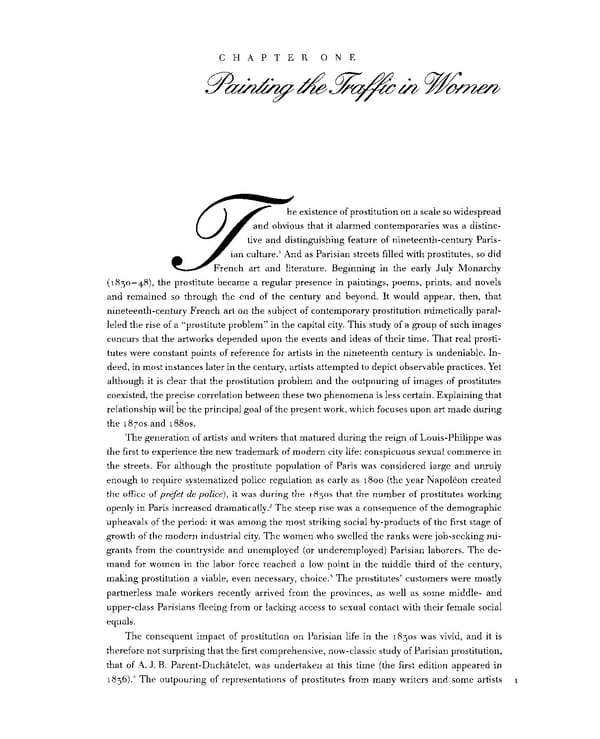CHAPTER ONE Painting the Traffic in Women he existence of prostitution on a scale so widespread and obvious that it alarmed contemporaries was a distinc- tive and distinguishing feature of nineteenth-century Paris- 1 T ian culture. And as Parisian streets filled with prostitutes, so did French art and literature. Beginning in the early July Monarchy (1830-48), the prostitute became a regular presence in paintings, poems, prints, and novels and remained so through the end of the century and beyond. It would appear, then, that nineteenth-century French art on the subject of contemporary prostitution mimetically paral- leled the rise of a "prostitute problem" in the capital city. This study of a group of such images concurs that the artworks depended upon the events and ideas of their time. That real prosti- tutes were constant points of reference for artists in the nineteenth century is undeniable. In- deed, in most instances later in the century, artists attempted to depict observable practices. Yet although it is clear that the prostitution problem and the outpouring of images of prostitutes coexisted, the precise correlation between these two phenomena is less certain. Explaining that relationship will be the principal goal of the present work, which focuses upon art made during the 18708 and i88os. The generation of artists and writers that matured during the reign of Louis-Philippe was the first to experience the new trademark of modern city life: conspicuous sexual commerce in the streets. For although the prostitute population of Paris was considered large and unruly enough to require systematized police regulation as early as 1800 (the year Napoleon created the office of prefet de police), it was during the 18305 that the number of prostitutes working 2 openly in Paris increased dramatically. The steep rise was a consequence of the demographic upheavals of the period: it was among the most striking social by-products of the first stage of growth of the modern industrial city. The women who swelled the ranks were job-seeking mi- grants from the countryside and unemployed (or underemployed) Parisian laborers. The de- mand for women in the labor force reached a low point in the middle third of the century, making prostitution a viable, even necessary, choice.3 The prostitutes' customers were mostly partnerless male workers recently arrived from the provinces, as well as some middle- and upper-class Parisians fleeing from or lacking access to sexual contact with their female social equals. The consequent impact of prostitution on Parisian life in the 18308 was vivid, and it is therefore not surprising that the first comprehensive, now-classic study of Parisian prostitution, that of A. J. B. Parent-Duchatelet, was undertaken at this time (the first edition appeared in 4 i836). The outpouring of representations of prostitutes from many writers and some artists i
 Prostitution & Impressionists Page 21 Page 23
Prostitution & Impressionists Page 21 Page 23